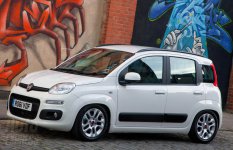In the Netherlands you can only get the 85 hp Twin Air version at the moment.
There is no market for the 1.2 overhere because of tax reasons.
100 gram or less CO2 means no road tax, the 1.2 has 120 Gram CO2, so nobody will buy that.
Later this year we will see the 65 hp turbo-less Twin Air, and by the end of the year maybe a 105 hp Twin Air (sport).
I doubt it will have less then 100 gram CO2 though, but it is possible.
Remapping the 85 Twin Air means 95 hp and 188 Nm of torque.
For more power you need a bigger turbo, 98 hp is the end of this one.
The most important thing to do with the new 2012 Panda is to install a coilover kit.
There is no market for the 1.2 overhere because of tax reasons.
100 gram or less CO2 means no road tax, the 1.2 has 120 Gram CO2, so nobody will buy that.
Later this year we will see the 65 hp turbo-less Twin Air, and by the end of the year maybe a 105 hp Twin Air (sport).
I doubt it will have less then 100 gram CO2 though, but it is possible.
Remapping the 85 Twin Air means 95 hp and 188 Nm of torque.
For more power you need a bigger turbo, 98 hp is the end of this one.
The most important thing to do with the new 2012 Panda is to install a coilover kit.


